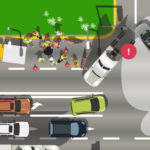What is computer vision and how is it changing the world of auto insurance
New companies are using in-car technologies to offer tailored insurance policies based on actual driver behavior. In addition, AI-enhanced automobiles enable new way to assess possible damages in the event of an accident, automating insurance claim processes.

For a machine, an image is nothing more than a set of numbers. A lifeless array of pixels that says nothing about the actual content it represents. Or, at least, that is what it used to be like before the latest advances in computer vision, a branch of artificial intelligence (AI) that not only teaches machines to look at things, but trains them to understand what they are looking at, just like humans do.
This technology is used by self-driving cars to tell the difference between a paper bag and a rock in the middle of the road. It is also the technology that tells Snapchat’s face swap filter where to place a dog's snout on a human face. And while applications are still emerging, an increasing number of companies is starting to look at this technology as a way to make insurance claims processes easier and more efficient, one of the insurtech industry’s biggest challenges.
Traditionally, the auto insurance fees that users pay are based on the profiles insurance companies build factoring in age, number of years driving and other information. In the event of an accident, a long and tedious process is launched, whereby the company tries to ascertain how the events took place and assess the damage before paying any agreed sum.
Higher accuracy than humans
All this could change in a matter of years thanks to computer vision. An example of this is Tractable, an auto and home damage assessment platform that uses AI technologies to estimate repair prices automatically. Founded in 2014, this 'startup', with offices in London and San Francisco, has managed to raise nearly $10 million in funding, including $8 million in an investment round series A in June 2017.
Tractable’s computer vision algorithms use deep learning to assess and review insurance claims and determine the value of the damages through image analysis, in a much faster and more accurate manner than a human is capable of. The company already works with some of the largest insurance companies in the US and the UK, such as Ageas; as well as Mitchell International, a company that develops software used by the automotive industry to manage collision and medical claims, parts and labor estimates, and glass replacement quotes.
Thanks to a rich database with tagged images, Tractable has trained its algorithms to perform highly accurate automatic assessments. In addition, drawing on information from past cases to learn on an ongoing basis, the company has managed to create a scalable software infrastructure that improves over time.
Ready for AI
Tractable is one of the standout startups in innovation consulting company Tällt Ventures’ ‘Insurtech Disruption Trends 2017. Artificial Intelligence’ report, which analyzes case studies of 'insurtech' companies that are using AI in their business model. "In an age where human accuracy has been surpassed by technology in image classification, Tractable makes a strong business case for improving operational efficiencies in insurance" says the report.
The sector 'insurtech' grows apace: according to a recent report by Accenture Technology Vision for Insurance 2017, during the last quarter 64 operations were closed for a total value of 985 million, a record figure that represents an increase of 148% over last year. The report also concluded that 79% of global insurers agree that the AI will revolutionize the way in which the industry gathers information and makes decisions.
The car that doesn’t lie
One of the most crucial tasks that insurers face every day is determining the price of insurance based on their customers’ records. But, what if cars themselves were able to collect information about user driving patterns? Based on this idea, 'startup' Nauto has created a safe-driving tool that uses images, motion sensors and GPS location for gather real-time information about the vehicle. The system uses computer vision to determine what happens both on the road and in the car, warning the driver about possible hazards or distractions.
Thanks to all this information, the company generates comprehensive data logs to render a driving profile based on which it is possible to create tailored insurance policies that fit each customer. The system is capable of detecting signs of stress on drivers’ faces based on computer vision algorithms, offering them constant feedback on how to improve their road habits. Nauto focuses particularly on fleets of drivers of freight companies, where these type of logs are vital for business and employee safety.
The company, whose success story is also included in Tällt Ventures' report, has engaged in a series of investment rounds which have attracted the interests of companies as CVCs Ventures Allianz, BMW and Toyota Research Institute have participated. In July 2017, the start-up raised $159 million in series B funding. As its customer base grows larger, the company expects its data sets to provide insurance companies with a more comprehensive basis to assess risk with increasing accuracy. And later, the companies hopes that the learning generated based on this wealth of information will help tomorrow’s self-driving cars to see better.